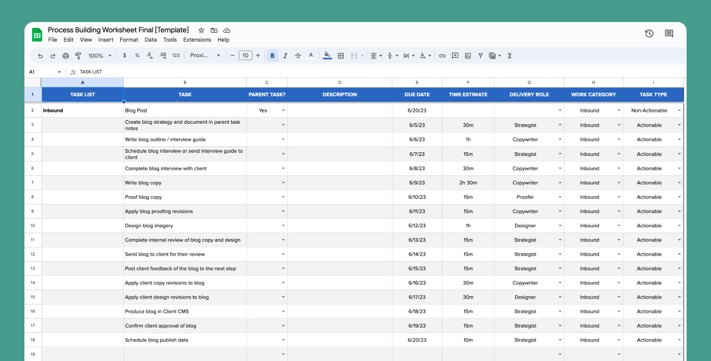What is Teamwork?
Teamwork is a well-established and rapidly developing project management platform; the only platform built specifically for client work, i.e. with digital agencies and professional services firms in mind.
It has all the features a digital agency could need in a project management tool:
- Carefully designed hierarchy for project and task management.
- Customizable permissions for working with team members, contractors, and clients.
- Integrated time tracking and estimates.
- Customizable dashboards and reporting tools.
- A myriad of views: lists, boards, calendars, Gantt, timelines, workloads, etc.
- Native docs and chat, notifications and reminders, tags, custom fields, and more.
But, although Teamwork is a fantastic project management tool for agencies – having the right tool for the job is worth its weight in gold – your overarching system for client delivery matters more than the specific PM tool you employ.
In this guide, we'll be covering both how to get the most out of Teamwork as well as how to think about work management in general at your agency.
“The shared North Star we have for serving agencies, helping them become more productive & profitable, makes ZenPilot an incredibly valuable Teamwork Solution Partner.
They’ve developed a deep understanding of the agency business model from the 1,000's of agencies they’ve consulted over the years.
That experience translates directly into expertise that helps our customers get going faster & more efficiently with Teamwork.”
 Peter Coppinger
Teamwork Founder & CEO
Peter Coppinger
Teamwork Founder & CEO
Why Teamwork for Agencies?
This question comes up all the time. There are a lot of strong PM tools out there, but Teamwork has a strict target market offering them a competitive edge.
They aren't focused on delivering a robust project management tool for every business out there; they are focused on agencies, making every new feature geared towards taming the chaos of #agencylife.
But besides Teamwork's focus on agencies, we recommend Teamwork specifically because:
- It includes key client work features like invoicing, Quickbooks integrations, unlimited free client seats, and freelance collaborators.
- Their native time tracking makes reporting much simpler and more accurate than tying together separate tools.
- They offer custom billable and cost rates for every team member, helping executives know how profitable they really are.
- Their out-of-the-box agency-specific reporting to show project health, utilization, and profitability is unmatched.
- Their advanced workload and capacity planning helps account managers and project managers forecast and plan work.
- Pricing-wise, Teamwork is very friendly for scaling agency teams.
We'll cover a few of these points later in this guide, but this is not an exhaustive discussion on the merits of Teamwork vs. other agency project management tools.
To begin, let's set the technology aside and focus on how you'll actually navigate your operational challenges in your organization effectively.
The Formula for Taming the Chaos of Agency Life
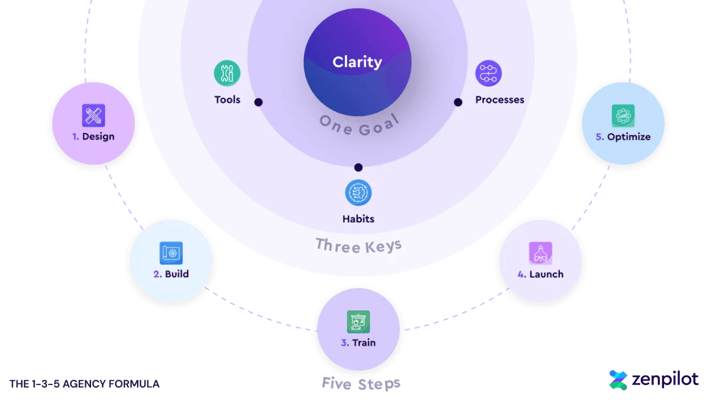
Regardless of the tool, every project management platform implementation has a clearly defined goal - clarity.
Over the past 10+ years, we've helped almost 3,000 agencies achieve clarity through our approach we call the 1-3-5 Formula.
One Goal - Clarity
The number '1' in the 1-3-5 Formula stands for our primary goal, which is to create clarity at every level of an organization.
- For leadership, clarity means understanding key business metrics.
- For managers, clarity means knowing the performance of their team or their set of clients.
- For individual contributors, clarity means being aware of what's on their plate daily and the tasks that need to be completed.
Three Key Components - Tools, Processes, and Habits
Once you define the goal, the next number, '3', represents three key components to achieve it: tools, processes, and habits.
- You need the right tools in place for efficient operations. But that's not all.
- You also need well-defined processes to decrease the mental load on your team, improve hand-offs and keep projects on track.
- And you need healthy habits across the team to bring everything together. Without good habits, even the best tools and processes will fall short of delivering the desired results.
Five Steps to Success
The final number '5' refers to the five-step method we advocate to reach operational excellence: design, build, train, launch, and optimize.
- Design - Design a system that will help your organization establish a clear vision of the ideal solution. This should encapsulate behavioral standards, procedural excellence, and the technical blueprint for world-class tooling.
- Build - Take your design, standards, and blueprint and build out the processes in your PM tool.
- Train - Train your team on the habits and processes that will make your agency successful. This includes setting clear rules of engagement and empowering your team with the right knowledge and resources.
- Launch - Launch the new system and monitor its use and effectiveness.
- Optimize - Observe what works and what doesn't and make changes accordingly.
The Only Fully Guaranteed Agency Operations Improvement Framework
Get 360 clarity into your operations or your money back, guaranteed.
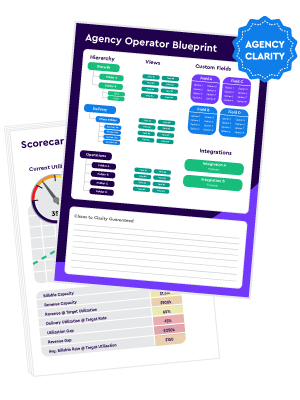
Trust the Process
To achieve your goal, you need to eliminate friction between people, technology, and processes.
Each step we've listed is equally important. Do NOT rush. Prepare yourself to spend the next few months implementing Teamwork.
And yes, that may sound like a lot of time, but you're doing more than implementing a project management tool; you're completely transforming the way that you operate, in a good way. 🙂
If you get this right the first time, it will save you a lot of headaches.
Read through this guide cover to cover before jumping into Teamwork.
And if you need a trusted agency operations specialist to lead you through this journey quickly and confidently, book a call here.
Understanding Teamwork
Organizing Work at Your Agency
It's a common pitfall for agencies to limit their potential progress by neglecting to consider the agency's own internal work in their project management approach.
With the pressure to deliver for clients, it's all too easy to prioritize client needs over your own.
This issue is glaringly apparent when examining the marketing strategies of numerous agencies.
Agency owners are amazing marketers, but can often set aside the whole "running a business" part of the gig.
We need to step up and do better.
It's crucial to plan, manage, and track internal work, along with client work, in the same unified system to achieve a comprehensive view of progress, workload, and time allocation.
Your work in all three areas of your business should be reflected in your PM tool.
Let's look at the best way to do this.
We break every agency business down into 3 areas:
- Growth – this covers your business development activities, including marketing and sales.
- Delivery – this covers all client service-related tasks.
- Operations – this covers the remaining aspects of your business, mainly human resources, finance, and legal responsibilities.
Your work in all 3 areas of your business should be reflected in your PM tool.
To summarize, Growth is where you make your commitment, Delivery is where you fulfill that commitment, and Operations acts as the vital 'catch-all' drawer—keeping the business running smoothly, fostering team growth, protecting your business, and investing in self-improvement.
The business model is simple, not easy.
Let's walk through exactly how to set this up in Teamwork.
Before you get started
Take the Agency Project Management Benchmark Assessment so you know what areas to prioritize.
How to Structure Your Agency’s Work in Teamwork
Before we get too technical, let's briefly cover Teamwork's hierarchy.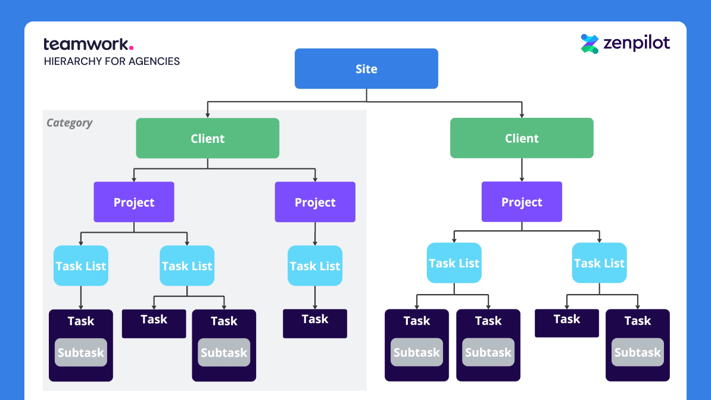
Site
When you sign up for Teamwork, you create both your user account and your site.
Your Teamwork site is the highest level in Teamwork's hierarchy. It's typically named after your business, and all work falls into one site.
Clients
Clients are the next level in the hierarchy. They represent, well, your clients. Just never forget that you are your own client (and MOST IMPORTANT client).
Categories
Although categories do not function as a real layer in the hierarchy, they are how you will organize and bucket your projects.
These are especially valuable internally to separate work into Growth and Operational buckets.
Projects
Projects are created within your clients and will be used to group together your work for clients.
For example, if you had a monthly retainer and a website project for a client, these would represent two different projects.
Each project can have specific people, budgets, and be deemed billable or non-billable.
Task Lists
Task lists are where the work – parent tasks and subtasks – lives.
Task lists help us group related activities (tasks) together. These task lists become work categories or phases within a project.
Parent Tasks and Subtasks
Tasks are the smallest unit in the Teamwork hierarchy. They're created within task lists and represent the individual actions that need to be completed.
Tasks are broken into parent tasks and subtasks.
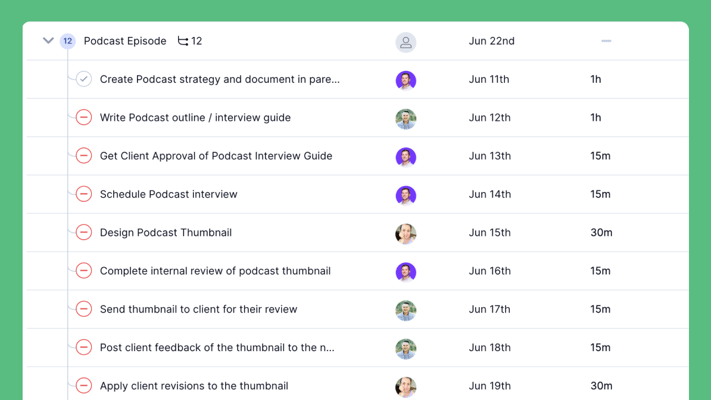
Now that we've discussed an overview of the Teamwork hierarchy, let's jump into a more technical discussion about how your work needs to be structured in the tool.
Structuring Your Delivery Work
For this example, we're going to specifically focus on Delivery work and get the
Project and Task List correct there first.
Inside each Client, set up Projects for each separate billable item that you're providing for your clients.
- Retainer - Project for all tasks associated with a client's monthly, quarterly, or yearly retainer.
- [Website] Project - Project related to a one-off billable item that is NOT included in their retainer.
- Account Management - Project for all related account management tasks (project management, meetings, etc.) This only needs to be created if this is a separate billable item.
If you get your structure right, you'll unlock a lot of visibility for you and your team.
Understanding Views for Each Agency Role
Every agency, or any business for that matter, has at least four roles that are each looking for distinct views inside their project management tool.
Thankfully, Teamwork comes with a lot of out-of-the-box views and reports for every member of your team.
Though these views and reports are pre-configured, you need to populate them with real data to make them meaningful. We will jump into that conversation in a few minutes, but for now, let's focus on what Teamwork can bring to the table for each role.
1. Individual Contributors (Worker Bees)
With Teamwork, every member of your agency has a dedicated "My Work" tab on the Home screen. This is the best place for them to see ALL of their work across every client, project, and internal work.
Additionally, they'll have a personal dashboard where they can see upcoming events, logged time, active tasks, and an overview of all of the projects they're invited to.
Note: This can be edited, but it covers the bases for what a worker bee is going to need.
2. Account Managers
Your Account Managers can create custom dashboards and reports specific to their book of business.
Each report can be filtered to specific clients, giving your account management team a holistic view of progress on projects. And if an issue arises, they can drill into the details and make sure they update the project health report for the rest of the team to know.
3. Team Leads
Team Leads can check in on the Workload Planner and Schedule views to manage and plan work for their team.
As long as every task has due dates, time estimates, and assignees, your team leads will be able to see how much bandwidth the team has.
4. Leadership
This is where Teamwork excels. As an executive, you'll have amazing visibility into what's happening at your agency.
- Forecasting - Use the Workload Planner to see exactly how much time your team has available (just remember - this is built from tasks having due dates, time estimates, and assignees, but more on that later 😉)
- Project Health - Use the Project Health report to see internal project health scores, account management updates, budgets, and task overviews.
- Utilization - Use the Utilization report to see a breakdown of estimated time, tracked time, and billable vs. non-billable time per employee.
- Profitability - Understand exactly how profitable each project and/or client is in the Project Report with customizable billable rates, cost rates, and budgets.
Bonus: Your Clients
Yes, your clients need to know what's happening as well. Plus, if you want them to provide feedback and complete their work, you'll want to make sure they have visibility.
In Teamwork, you can invite your clients into their projects and provide them limited visibility to show them only what they need.
Phase 1: Design
Understand Your Agency's Problems
With a basic understanding of how Teamwork operates, it's time to dive into the work at hand.
To begin, you need to gain a comprehensive understanding of your agency's primary areas of friction and discomfort. We suggest starting by surveying your team.
Craft a survey that covers the following points:
- Are team members aware of their daily responsibilities?
- Do they feel their role is well-defined?
- Do they feel the team is delivering high-quality work to your clients?
Ensure that the survey is anonymous (if necessary) so that team members can provide honest feedback without fear of negative consequences.
Secondly, assess your current operation. Focus on these 7 key areas:
- Services & Methodology → What are your primary service lines and how do you structure client engagements? This is used for your task list structure.
- Tools & Communication → What project management, time tracking, and budgeting tools do you currently use?
- Resource Management → How do you manage forecasting and capacity planning?
- Account Management → Does your team have a standard meeting frequency, agenda, and follow-up process in place?
- Project Management → Who has the ability to add, manage, and adjust tasks in your current PM platform?
- Internal Knowledge Sharing → How many deliverables and projects are supported by documented processes within your organization?
- Contract Tracking & Reporting → What is your current process for tracking budgets for clients?
From both your team's and leadership's perspectives, you can create an excellent document outlining the issues, challenges, pain points, and objectives.
Audit Your PM & Processes
Now, it's time to thoroughly examine your current project management platform and processes (or lack thereof). Take a closer look at your existing setup with your team, particularly your project and account managers.
Identifying the root cause of friction is critical.
- Is it a technology issue?
- a process problem?
- or misaligned team expectations?
Blaming the technology is often misguided. More frequently, agencies lack pre-defined processes and training, leading to a disconnect in technology usage.
Remember, a project management platform solves nothing on its own.
To effectively address pain points, start by documenting them and categorizing them. Prioritize the issues that matter most to you and your team.
If you're unsure about how your current operation stacks up against industry standards, don't worry. You can benchmark yourself against 2,700+ other agencies using our free Agency PM Health Benchmark.
This 20-question survey will provide you with a unique result that you can compare to our benchmark database to see how your agency is performing.
Before you get started
Take the Agency Project Management Benchmark Assessment so you know what areas to prioritize.
Identify Key Processes and Prioritize
Once you have conducted a comprehensive assessment of your operations, it is time to take a break and understand all the services you offer to your clients.
For a successful implementation, agencies must have well-defined processes. We understand that every agency has various deliverables and projects in its arsenal, which is why it is crucial to prioritize what needs to be developed first.
Prioritization is the key to efficient agency functioning and focusing on the most important tasks. However, it should be viewed as a collaborative effort rather than a decision made by a single person for everyone else.
Bring your team together, identify the core functions of your business (marketing, sales, operations, etc.), and evaluate your agency's current strengths and weaknesses. This will provide you with the necessary data to create a proper roadmap.
Begin by listing everything you do for clients. Then prioritize it based on how difficult it is, how much documentation you have on it, and how frequently you perform it (you can use our Process Prioritization Worksheet).
This will give you an excellent starting point for determining which processes should be developed first.
Free Agency Resource
Get the exact Process Prioritization Framework we've used to help 2,700+ agencies prioritize and organize their processes.
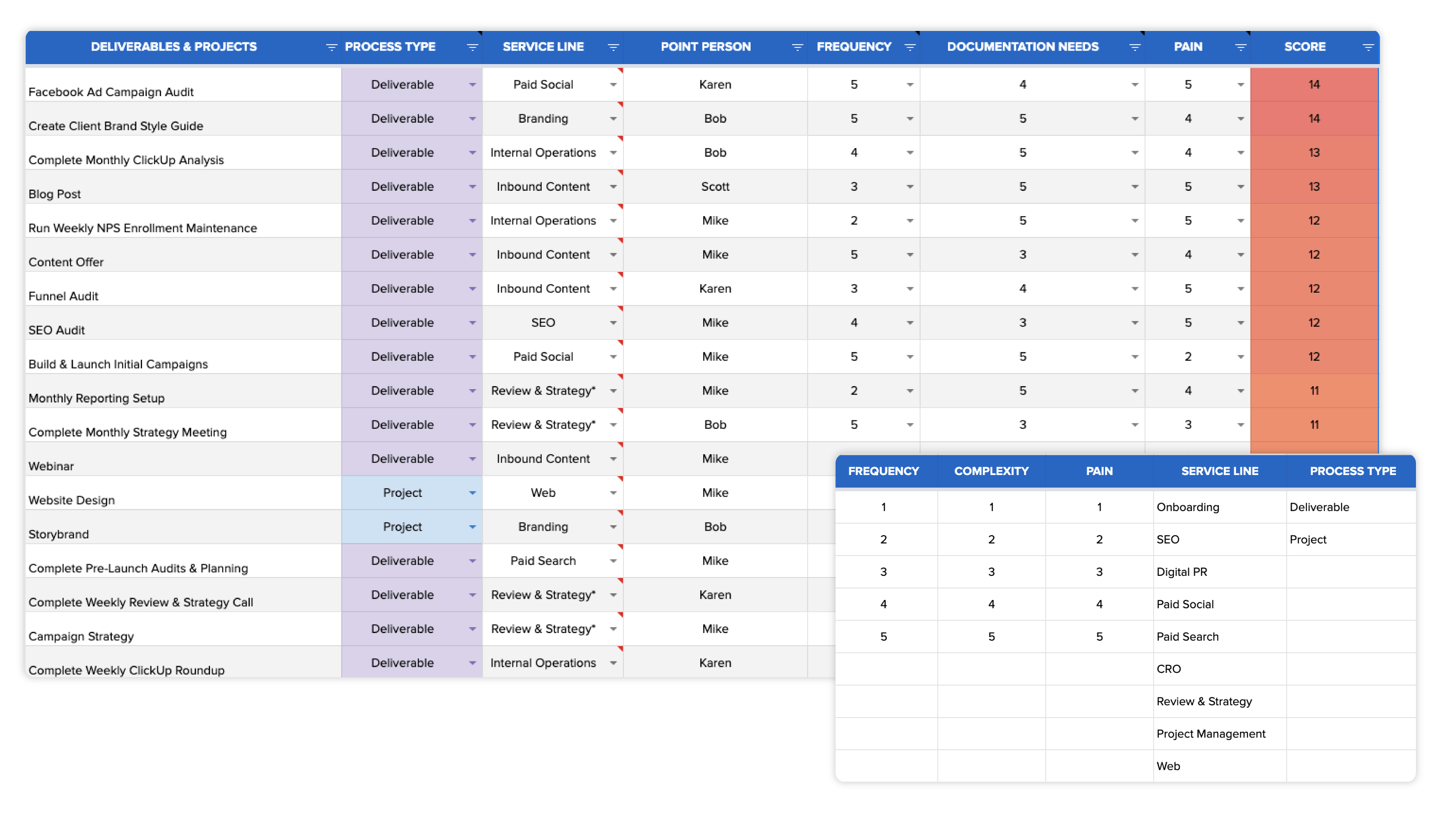
Do not worry about building anything yet; that will come soon.
The Finished Product - Your Blueprint
Finally, prior to diving into Teamwork, it is imperative that you first sketch out a technical blueprint.
This blueprint should serve as a detailed guide for your Teamwork hierarchy, views, custom fields, tags, and integrations.
We recommend sketching this out in Miro or Lucidchart to create your blueprint, as this will enable both you and your team to visualize, comprehend, and execute it effectively.
And remember, if you want an agency operations expert to create a detailed technical blueprint for you, book a call with us and let's get started.
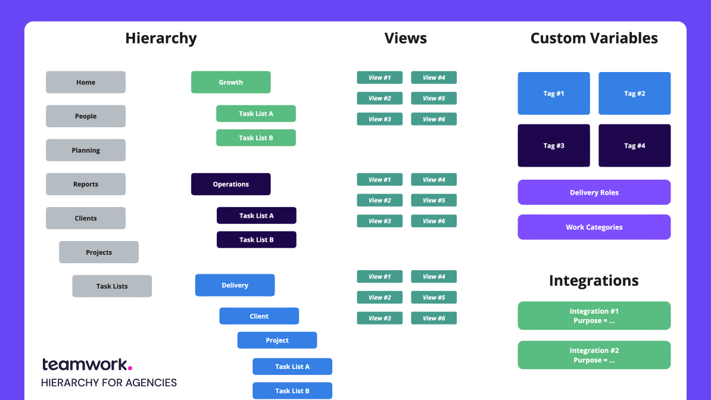
Phase 2: Build
Build Your Processes, Then Save as Templates
Building out your processes in the tool is one of the most crucial steps in implementing any PM platform.
Although it may be tempting to rush and get your team into the tool, DON'T. By skipping ahead, you run the risk of everything falling apart.
Before moving on to process building, you should have already identified and prioritized all your processes.
If you haven't done so yet, take a step back and complete that first. Since you won't have time to build everything at once, start with what's most important and necessary for launch.
Teamwork offers an awesome template library feature within the tool. However, you must first build out all your processes before this feature can become effective.
How to Build a Process Template in Teamwork
Your processes can be built, managed, and optimized directly in the template library.
However, we'd recommend you begin by creating a separate client space called Process Library. This allows you for easier editing and uploading processes from a spreadsheet into Teamwork.
So, before you do anything, create a separate Process Library client space and create different projects for Growth, Delivery, and Operations (example below).
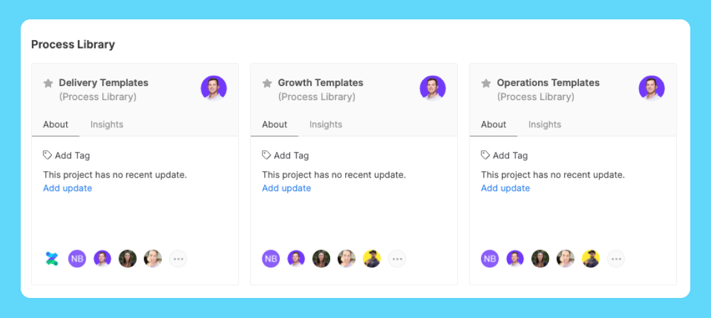
You'll utilize both Project and Task List templates to build out your agency's deliverables and projects.
Task List Template → Represents a smaller deliverable or a process that is often reused multiple times for a client. Task List templates are referred to as tools in your toolbox (e.g. Blog Post, Google Ad Daily Optimization, Podcast Episode).
Project Template → Represents a larger project that happens once with a clear start and end date (e.g. Website Redesign, HubSpot Implementation, Video Production).
Refer back to your Process Prioritization Worksheet for what should be built first.
However, if you're new to Teamwork or want a faster way to build your processes, you can leverage our Process Building Worksheet, which can upload templates directly to Teamwork. This spreadsheet will provide instructions you won't want to miss.
Teamwork Process Builder Worksheet
The FASTEST way to build your process templates for Teamwork.com.
Set Up Your Parent Tasks and Subtasks
Now that your Projects and Task Lists are in order, set up your Tasks as your deliverables and use Subtasks for each individually-owned task in the process.
Let's take a blog post as an example. The blog post itself will be your Task (call it "Blog Post: [Post Name]".
Now beneath that Task, we'll create Subtasks for each of the individual components:
- Develop blog strategy and document it → This is the task (Subtask in Teamwork parlance) for the strategist.
- Write the first draft of the blog post and send to proofer → This is the task for the copywriter.
- Review the blog post and provide feedback → This is the task for the proofer.
- Make edits of blog post and send to client for review → This is the task for the copywriter.
- Receive feedback and make adjustments → This is the task for the copywriter.
- Send the blog to client for review→ This is the task for the strategist.
- Receive client feedback and make any necessary changes → This is the task for the copywriter.
- Design blog imagery → This is the task for the designer.
- Upload asset to website and launch! 🚀 → This is the task for the strategist.
For best results, assign each subtask to one person and ensure that they can complete it in one sitting, with a time estimate of no more than 4 hours.
This approach will promote efficient collaboration within the team, offer transparency to management, and ensure that nothing slips through the cracks.
Although some team members may resist this strategy, it is crucial to stick to it. It makes a BIG difference.
Set Up Your Task Processes
Inside each subtask, we'll use Teamwork's awesome task description feature to document the step-by-step process to complete these tasks.
We can pair this with videos, images, or additional resources linked up in the task descriptions to make sure that we're making the process live where work gets done and enabling team members to do their best work.
Add Tags to Tasks for Filtering
After you've built out your tasks and descriptions, make sure you also add any necessary tags to provide sorting and filtering capabilities in the future.
Adding a Delivery Role tag will be the most important. We'd also recommend adding a Service Line/Work Category tag and a Task Type tag to distinguish between different types of tasks – actionable, non-actionable, meetings, records, etc.
You'll find more details on these tags and additional task details in the Process Building Worksheet.
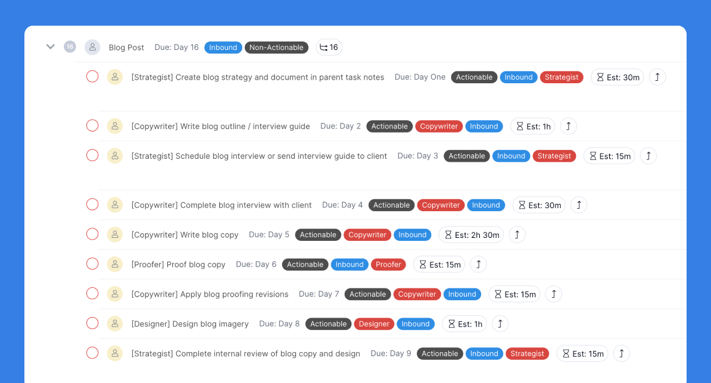
Checklist: What Makes a Great Template?
To keep an organized system, it's extremely important to make sure your processes are clean. They don't have to be perfect, but they need to be structurally sound to set your agency up for success. Follow this checklist below to ensure your templates are set up correctly:
-
Task Names → Subtask names should be action-oriented. Start with a verb to clarify what needs to be done (e.g. "Write Blog Post"). Parent Task names should be nouns (e.g. "Blog Post").
-
Process → Every Subtask should have a checklist for completion and any helpful context or other forms of instructions (video, pictures, etc.) in the description.
-
Time Estimates → Each Subtask should have an estimated amount of time.
-
Due Dates → Every Task should have a Due Date, and Subtasks should have correlated Due Dates. You will be able to remap dates based on the Task Due Date when you deploy your templates.
-
Tags → Every task should have a preset value for a Delivery Role, Work Category and Task Type tag.
- Assign Later → Every task should have a preset role in brackets (e.g. [Strategist] Create blog strategy and document in parent task notes) for assigning the work in the future. This should match the Delivery Role Tag.
-
Consistency → Your naming structure and format should be consistent.
Save Your Templates in the Template Center
After you've worked through the checklist and you feel good about your task list and project templates, it's time to save them into the Teamwork template library.
At this point, you've created your source files, but they aren't templates yet. This is important so that you have an organized place to edit and update your processes in the future!
If you can get all of these pieces right out of the gate, you’ll save yourself a lot of headaches in the future, plus reap the benefit of having a polished and professional look for your team and clients.
Build Your Teamwork Workspace
Now that you've designed the system and documented all of your processes inside of Teamwork, it's time for the fun part. Let's begin to get everything set up inside your workspace.
If you haven't already, make sure all of your categories are set up – Growth, Delivery & Operations.
Next, begin setting up your Clients inside of Teamwork. You don't need to add all the tasks yet, but the structure needs to be set so that you and the team will know where every task should live.
Remember, your work in all three areas of your business should be reflected in your PM tool. Aside from just setting up Teamwork, it's important to determine what other tools need to communicate with Teamwork as well (e.g. HubSpot, Slack, Google Workspace, Typeform, etc.). Get these integrated with Teamwork before launch to make sure the team is trained and ready to go on day 1.
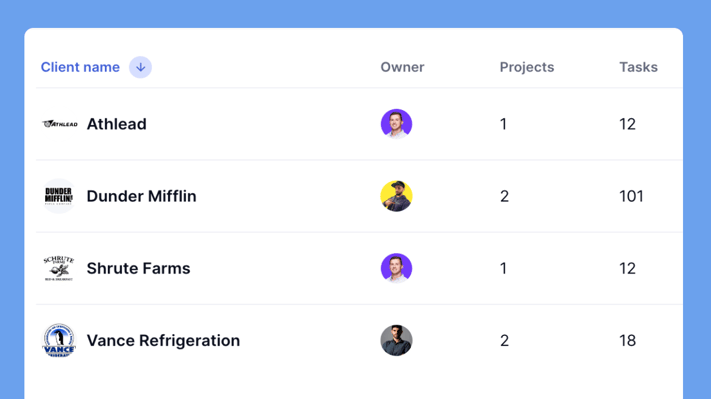
Phase 3: Train
Pick a Launch Date and Create a Migration Plan
One common stumbling block for agency teams when implementing Teamwork is their migration plan. Many times, they face issues such as part of the team migrating as early adopters, a few client projects being moved, and one client project being maintained in two separate systems.
This situation often leads to problems where someone can't find the necessary information and realizes it's in the other system. As a result, things become messy, people get frustrated, and the momentum of the migration project stalls.
To avoid these pitfalls, it is essential to establish a clear launch date for migrating to Teamwork. This date should be set between 2 weeks and 6–8 weeks in the future. Once the launch date is determined, create a comprehensive launch plan and share it with your team.
Before launch, you need to:
-
Set up your structure correctly.
-
Develop and implement standardized processes and templates.
-
Train your entire team on the unified way you'll use the software.
-
Set up any required integrations with other tools or systems.
-
Migrate your active work and configure it in Teamwork.
-
Organize a launch party to celebrate the transition 🎉
This is all worth it, but none of it is easy. Plan your project well and hold each other accountable to execute it well.
Pro Tip: set your team's expectations correctly. Change is hard, and many teams struggle with the new platform for the first week or two until they start to get value back out of the new system and new habits. The key is to push through the discomfort to reach the point where you start to earn the rewards from your investment.
If your team has been in Teamwork for a month or longer and they still don't like it or don't feel that it has added value, you need to take a hard look at your current setup and probably get outside eyes on the problem. It may be structural, or it may be cultural, but something is wrong.
And remember, if you need an agency operations expert who has taken almost 3,000 teams and over 10,000 people through this operational transformation, schedule a call with us.
Train Your Team on The Software AND Expectations
Setting your agency up for success while using Teamwork boils down to having the right framework, having clear rules of engagement, educating everyone on why and how to follow those rules, and then disciplined accountability in your execution.
That training piece should revolve around 2 types of education:
-
Ground Rules → Your expectations and ground rules around project management as a whole.
-
Basic Training → Orientation to Teamwork itself, your tool, and how to use it.
For example, we put every single agency team member of every single agency who works with us through a Project Management Certification program.
The first thing they learn is the 10 Commandments. These basic expectations are detailed and applied to real-world situations.
Commandment #1 is → If it's not in Teamwork, it didn't happen.
There's little value in doing things halfway. If you want the ability to accurately forecast your agency's workload, follow a trail to figure out where things went off track for a client project, or reward team members who deliver the best work, you need that work to be centralized in Teamwork.
Explain that expectation and show your team what that looks like.
If you're not working with us, build your own list of expectations and turn it into a training product for new hires.
Add detailed walkthroughs of how you want the tool to be used and the daily habits each team member needs to adopt.
Then keep that training up to date.
You will have better data to improve your decision-making, and your team will be more productive, aligned, and grateful.
Double Your Agency's Productivity.
You can build a happier, more productive, more profitable team with Teamwork. We'll show you how.
Phase 4: Launch
Migrate and Launch in Teamwork 🚀
Migration can be a stressful time. There's a lot of work to move over. Focus on migrating work for one client at a time. If you try to do too much at one time, work can slip through the cracks.
Additionally, it's important that you don't take the easy route and migrate work over with a CSV file import. You created process templates for a reason. Use them!
-
Clients → Begin by setting up your client spaces and setting up any projects related to these clients (e.g. retainer, website project, brand redesign, etc.)
-
Deliverables → Find the appropriate client space and begin deploying your task list templates. Teamwork allows you to remap due dates (and skip weekends) when deploying templates.
-
Project Tasks→ Project tasks also need to be deployed. Go to the appropriate client and deploy the appropriate project template.
-
Assign Work → If you've leveraged the "Choose Later (Assignee)" functionality in Teamwork, you'll be able to assign tasks easily when deploying your templates.
-
Complete Completed Tasks → Match your deliverables and projects up with where the work is in your old system. If there are any tasks in your new process that you just deployed that are complete, mark them as complete in Teamwork!
-
One-Off Tasks → If there are any random tasks that aren't in a template, add them as one-off tasks in the system. Make sure they have an assignee, a due date, and a time estimate.
-
Finalize & Repeat → Double check to make sure work matches reality. After you've finished migrating work for this client, move on to the next!
-
Launch → After all client work has been finished, you're ready to launch!
Migrating client work is the most important. After you've completed your Delivery work, continue setting up your Growth and Operations.
Phase 5: Optimize
Hold Everyone Accountable
Once you've launched Teamwork at your agency, there are a handful of specific things you should do to help your team get up to speed quickly and then hold everyone accountable to the standards you've set.
Specifically, within the first 2 weeks, you should set up a 1-on-1 meeting with each team member to assess their usage and spot any issues as early as possible.
Look at obvious things like their time tracked and time estimated totals, overdue tasks, completed tasks, and profile setup.
We recommend you follow this Four Step Accountability Process:
-
Analyze Performance - Monitor, record, and analyze workspace, task, and team member performance.
-
Prioritize Issues - Prioritize which issues have the greatest impact on workflow.
-
Optimize Your System - Design and implement new solutions to solve workflow issues.
-
Team Activation - Train the team on new solutions to help them be more efficient.
Assign a Teamwork Champion
It's important to note that the agency owner should not be solely responsible for monitoring Teamwork usage and spotting issues.
While this may be excused in very small firms for a short period of time, it typically leads to negative outcomes.
Instead, designate someone internally to be your Teamwork Champion.
This individual will conduct consistent checks, address minor issues, escalate major issues when necessary, and provide insights and aggregated data to the management team.
By establishing accountability, analysis, and improvement cadences, you can cultivate healthy habits within your team.
Teamwork Champion Responsibilities
-
The Daily Spot Check → a 10-30 minute (depending on firm size) audit at the end of each work day.
-
The Weekly Roundup → a slightly deeper dive on a weekly basis that leads to a short aggregated report to management.
-
The Monthly Review → a monthly review that pulls data for management that should impact resource allocation, project scoping, pricing, etc.
-
The Quarterly Analysis → a comprehensive analysis that impacts time estimates, project planning, recruiting and hiring, client relationships, etc.
Don't skip these tasks.
Build out a well-documented process and hand it off to a detail-oriented team member who can follow the process and deliver the insights and accountability you need to get the most out of your investment in process development and Teamwork.
Additional Teamwork Resources
There's a lot more to understand about Teamwork than what we've discussed, but this is the exact methodology that you need to adapt to successfully lead the last project management software implementation you'll need.
If you want to get even more out of Teamwork, bookmark this tab and don't forget to subscribe to our newsletter.
We will be updating this guide with a variety of advanced Teamwork use cases:
-
How to Best Measure Client Health in Teamwork
-
Understanding Advanced Agency Reporting in Teamwork
-
Advanced Features in Teamwork You Need to Know About
-
How To Work With Clients in Teamwork
BONUS
Download the Complete Teamwork.com for Agencies Guide FREE
The 42-page guide includes graphics, checklists, and links to how-to videos so you can actionize your Teamwork plan.
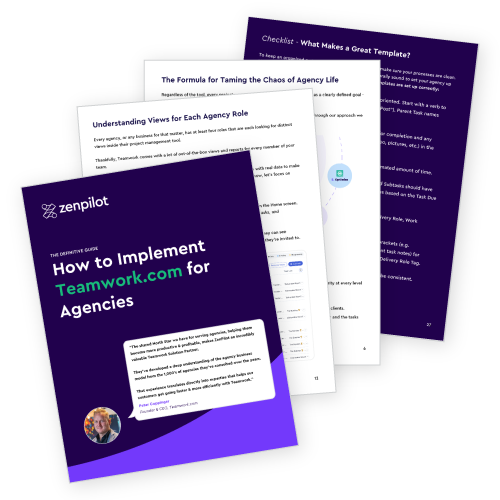
Want an Agency Operations Specialist & The Best Teamwork.com Partner?
At this point, you've hopefully successfully self-implemented Teamwork and are experiencing a much healthier, more productive, and more profitable team. If you did, let us know! We'd love to hear about your success story.
However, If you want the easy button for taking the chaos out of project management and getting Teamwork fully implemented for your agency – especially if you absolutely CAN'T afford for your implementation to fail – schedule a call here.
→ We've helped agency owners increase productivity by 400%, completely remove themselves from operations, and sell their business.
→ We've helped agencies grow profits by $1.2 million in year 1, triple headcount seamlessly, and improve client retention.
→ We've helped lead complete culture resets, increased employee satisfaction, and slashed team turnover.
Taking your operations seriously will change your life. It will give you freedom and peace of mind that you didn't think was possible. We want you to experience this life-changing impact.
If you're ready to experience the power of gold-standard operations, schedule your free ops strategy call here.
